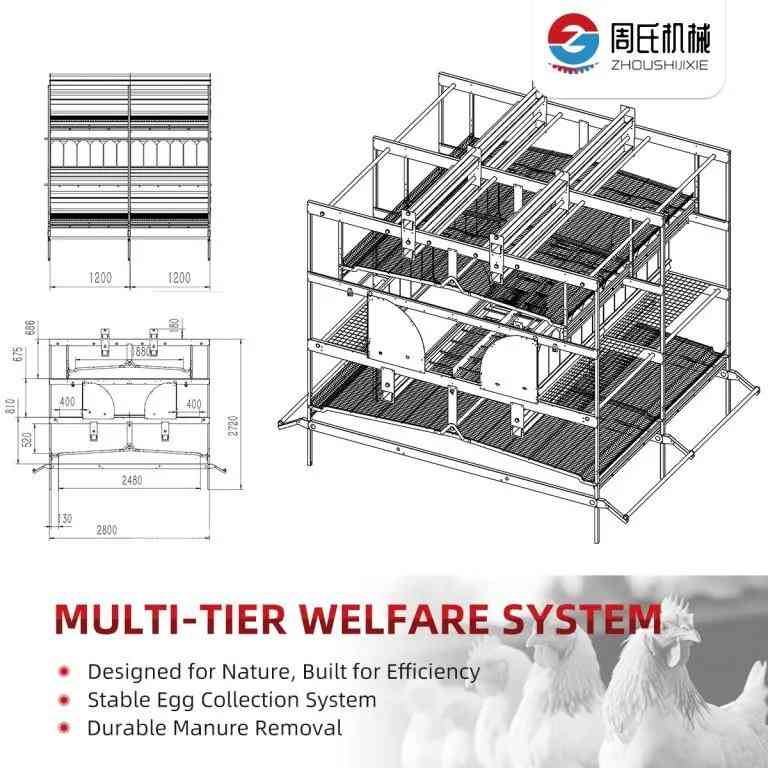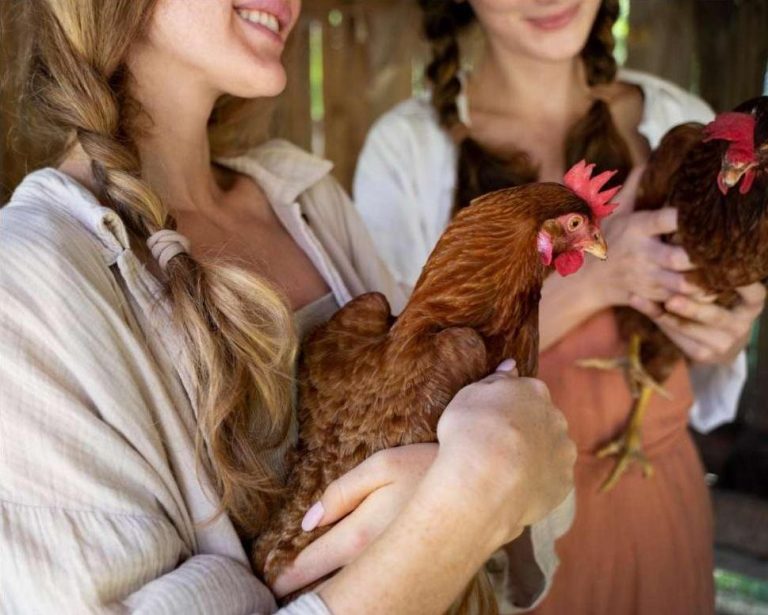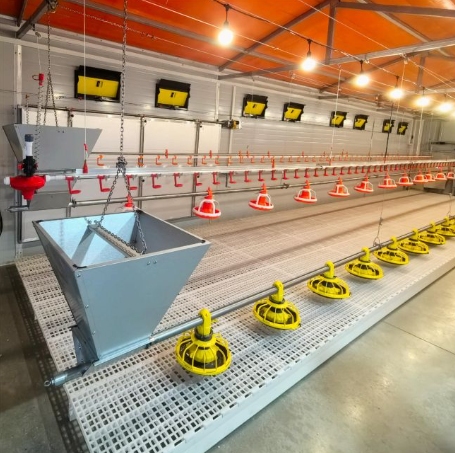
The Importance of Poultry House Equipment in Chick Rearing
Ensuring Optimal Living Conditions for Chicks
Ensuring a setting is essential for raising chicks successfully, and the equipment used in poultry houses is vital for this purpose. This includes poultry housing like H-type stacked chicken cages, which help maximize space and enhance operational efficiency. These cages are ideal for enclosed farms with more than 25k birds as they save floor area and allow for more animals to be housed, resultantly cutting in lower labor and running expenses. Furthermore, the chicken coop is oriented in an east-west direction. Designed with carefully positioned air vents and a sloped concrete floor to create a healthy and structured environment for the chicks to thrive in.
The Role of Equipment in Maintaining Hygiene Standards
Maintaining cleanliness is vital in poultry farming to prevent diseases and promote the well-being of the birds. The use of tools like automatic manure removal systems helps keep poultry houses clean effectively. Manure belts efficiently gather waste. Transport it outside using horizontal belts to uphold a hygienic setting. In addition to the cage structures made from dip galvanized materials are resistant to corrosion, making cleaning and disinfection processes easier.
Temperature Control and Ventilation Systems
The Impact of Temperature Regulation on Chick Development
Maintaining the temperature is crucial for the healthy growth of chicks as it affects their metabolism and overall development progress significantly. Advanced environmental control systems installed in chicken farms play a key role in keeping the temperature at an optimal level. Features like pressure fans and cooling water curtains, along with side windows, help create a stable microclimate inside the facility. These mechanisms work together to protect the chicks from heat stress and cold exposure, ensuring that they grow consistently at a pace.
Ventilation Systems and Air Quality Management
Maintaining ventilation is crucial for controlling air quality by eliminating ammonia accumulation and ensuring there is enough oxygen available, in the space. Computer controlled ventilation systems are used to determine the airflow to create an optimal environment. These systems not improve air circulation but also help prevent diseases by reducing the spread of harmful pathogens.
Feeding and Watering Systems in Poultry Houses
Automated Feeding Systems for Consistent Nutrition
Automated feeding systems play a role in ensuring that chicks receive a steady supply of nutrition consistently over time. They use a feeding mechanism that helps prevent feed wastage by avoiding overcrowding during distribution. Moreover, the ability to adjust feed levels allows for meeting the nutritional requirements of chicks at different stages of growth. This helps promote growth rates among all the chicks in the flock while also reducing the amount of manual labor needed for operations.
Efficient Watering Systems to Prevent Dehydration
Hydrating systems play a role, in keeping chicks well hydrated with PVC40 water pipes equipped with mechanical dosing systems efficiently delivering clean drinking water to them. Additionally water shortage alarms add to the reliability of the setup by notifying farm managers when maintenance is needed.
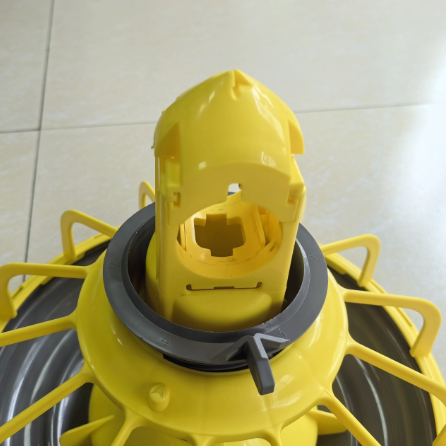
Lighting Systems and Their Influence on Growth
The Role of Light Intensity in Chick Behavior and Development
The brightness of the light has an effect on how chicks behave and their physical processes, like eating habits and sleeping routines are influenced by it too.The latest lighting setups commonly utilize 48 volt LED bulbs that provide lighting while also saving energy.These lights are made to be waterproof and secure to ensure they last long and work effectively.
Adjustable Lighting for Different Growth Stages
As young chickens matured into adulthood on the farm settings environment where they grow under lighting conditions mimicking natural day night cycles tailored to their developmental stages, for optimal growth and well being support.
Flooring and Bedding Options for Healthy Chicks
Non-Slip Flooring to Prevent Injuries
Floor covering is crucial in keeping chicks safe and avoiding injuries from slips and falls in their living environment for concrete floors with textured surfaces that offer grip and stability to minimize accidents caused by slippery areas ensuring a safer environment for the chicks to move around freely and comfortably while also allowing for efficient drainage with a gentle incline towards waste disposal channels, during routine cleaning procedures.
Bedding Materials That Enhance Comfort and Absorb Moisture
Using the bedding materials improves the comfort and cleanliness, in the chicken coop. Good absorbent bedding helps to prevent excess moisture buildup and lowers ammonia levels that can affect the birds respiratory health.
They offer cutting edge equipment for poultry houses designed to suit farming requirements at Zeus company. Their solutions range from high tech feeding systems to automated controls that guarantee ideal conditions, for raising chicks and boost productivity on farms globally.
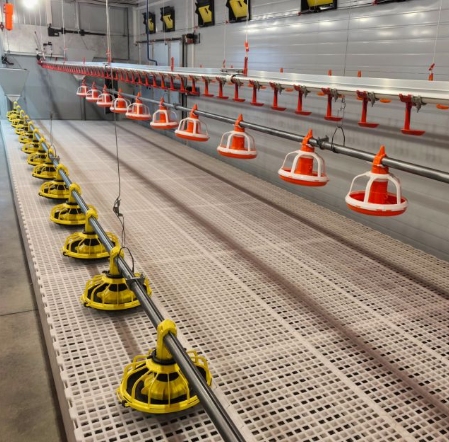
Disease Prevention Through Advanced Equipment
Biosecurity Measures with Modern Poultry House Equipment
Ensuring biosecurity is crucial for poultry farming practice, and the use of modern equipment in poultry houses is key in upholding quality standards. The innovative H-type stacked chicken cages are specifically beneficial for large-scale operations as they optimize space usage and simplify management tasks. These cages are well suited for farms that accommodate than 25,000 birds in one location and help decrease the chances of disease spread by limiting contact between animals and their excrement. The design that stacks vertically not only helps in saving floor space but also improves cleanliness by allowing better air circulation and easier disposal of waste.
Building poultry houses with floors that are at least 8cm thick and slightly sloped toward manure ditches is important for biosecurity measures as it allows for effective drainage and prevents waste buildup that could lead to the spread of pathogens. Maintaining a distance of 10 to 15 meters between poultry houses is also essential to prevent cross-contamination by promoting ventilation and exposure to sunlight.
Disinfection Tools for Enhanced Sanitation
Disinfectant plays a role in preventing diseases on poultry farms by employing advanced equipment with user friendly features that guarantee thorough cleanliness and sanitation practices are followed diligently. For example; utilizing dip galvanized materials in constructing cages helps prevent corrosion and makes cleaning effortless to maintain hygienic surfaces, for prolonged periods.
Automated systems for managing manure help improve hygiene in poultry facilities by gathering waste and moving it outside using belts positioned across the area reducing the need for direct contact with possibly harmful substances thus ensuring a cleaner environment and enhanced safety measures, in large scale operations where manual cleaning would be challenging and less efficient.
Monitoring Systems for Improved Management
Using Sensors to Track Environmental Conditions
Keeping track of the environment is crucial for keeping poultry houses in shape! The high tech sensors in todays equipment give us updates on important factors like temperature and air quality.There are controllers that use this data to control ventilation systems and keep the climate just right inside the houses.Negative pressure fans and cooling water curtains work together to maintain a temperature and prevent heat stress, in the birds.
These sensors are also helpful in optimizing how resources are used on the farm by keeping an eye on the environmental conditions and making precise changes to the ventilation or heating systems as needed to save energy and cut down on operational expenses.They also send out automated alerts to notify farm managers of any deviations, from the established parameters which helps improve reliability.
Early Detection of Health Issues Through Monitoring Tools
Detecting health concerns early is essential to reduce losses in the poultry farming industry. Modern monitoring devices with light alarms give warnings on time regarding possible issues like a lack of water or equipment failures. For example, alerts for water scarcity integrated into drinking systems guarantee hydration for birds.
Furthermore these tools are capable of monitoring patterns that may indicate potential health issues in animals they are tracking.Catching changes in their eating or drinking habits through automated systems can serve as a warning sign of underlying problems.This proactive strategy not ensures the well being of the animals but also boosts efficiency by minimizing disruptions, from disease outbreaks.

FAQ
Q: Why choose automated poultry house equipment over manual systems?
A: Automated equipment in poultry houses provides benefits compared to manual systems by enhancing efficiency and lowering labor expenses while also improving biosecurity measures for the flocks well being. Automated feeding mechanisms help reduce feed wastage and ensure nutrition levels among all birds. Likewise automated manure cleaning systems are more effective at upholding hygiene standards, than manual methods.
Additionally ” automation decreases the interaction between humans and animals and their excrement,” which decreases the chances of spreading diseases.” Furthermore ” utilizing monitoring equipment improves management skills by offering immediate updates, on environmental situations and animal well being.”
Q: What ventilation equipment is necessary for poultry houses?
A: To maintain air quality in poultry houses ventilation is crucially important equipment, like negative pressure fans cooling water curtains side windows and deflectors work in conjunction controlled by environmental regulators to ensure the airflow is optimal.
Computer operated ventilation systems use sensor data to determine the airflow to maintain low levels of ammonia and optimize oxygen availability in large scale settings where manual ventilation adjustments would be challenging to implement effectively.
Q: How to clean poultry house equipment effectively?
A: Cleaning the equipment in a poultry house requires following a series of steps to make sure everything is properly sanitized.
- Remove all organic matter, such as manure or feed residues.
- Use high-pressure water jets to wash surfaces.
- Apply disinfectants approved for use in animal housing facilities.
- Rinse thoroughly to remove any chemical residues.
- Allow all surfaces to dry completely before reintroducing animals.
Dip galvanized materials commonly employed in contemporary cage building allow for simple maintenance by preventing rust formation and corrosion, while automated manure cleaning systems enhance this task by effectively gathering waste and removing it from the premises.
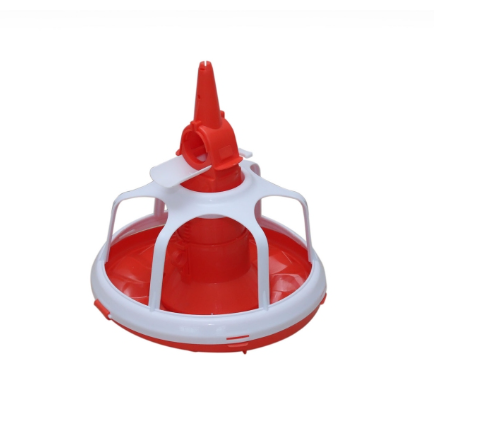
Contact Us
We at Zeus offer solutions designed to address various requirements, in the poultry farming industry. Our range of equipment includes of the line biosecurity protocols and advanced monitoring systems that not only support healthy chick growth but also improve productivity on farms worldwide.
If you have any questions regarding our products or services feel free to contact us on our website or send us an email through the contact page available, on the site.


